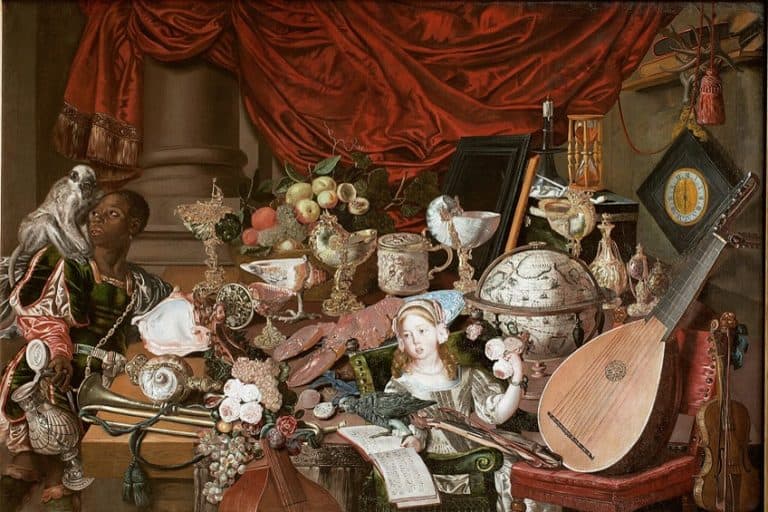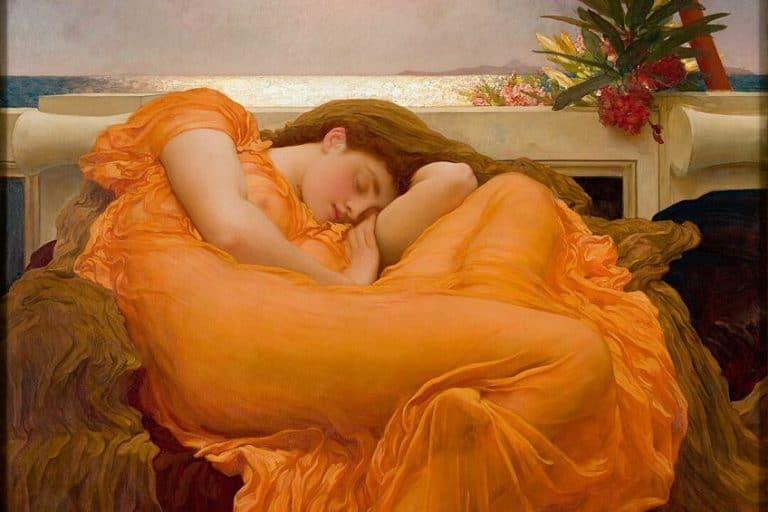“Oriental Poppies” by Georgia O’Keeffe – A Sensual Artistic Analysis
Oriental Poppies, a vibrant masterpiece by Georgia O’Keeffe, captures the bold and sensual beauty of nature through the artist’s unique vision. Created in 1927, this iconic painting features two oversized, brilliantly colored poppies that dominate the canvas with their intense orange and red hues. O’Keeffe’s pioneering approach to floral subjects, emphasizing their form and color on an exaggerated scale, invites viewers to explore the intricate details and emotional resonance of the natural world. Oriental Poppies exemplifies her ability to transform simple botanical subjects into powerful, almost abstract compositions, marking a significant contribution to American modernism and solidifying her legacy as a trailblazing figure in 20th-century art.
Key Takeaways
- O’Keeffe’s Oriental Poppies captures striking colors and forms.
- The 1927 painting is emblematic of the Precisionism art movement.
- The work remains significant in modern art, displayed at the Frederick R. Weisman Art Museum.
Artistic Context
| Artist | Georgia O’Keeffe (1887 – 1986) |
| Date Created | 1928 |
| Medium | Oil on canvas |
| Genre | Modernism |
| Period/Movement | American Modernism |
| Dimensions (cm) | 101.6 x 76.2 |
| Series/Versions | None |
| Where Is It Housed? | Weisman Art Museum, Minnesota, United States |
| What It Is Worth | Estimated at $30-40 million (value based on recent market trends) |
Oriental Poppies by Georgia O’Keeffe is a mesmerizing piece that exemplifies the artist’s bold exploration of color and form. Painted in 1927, O’Keeffe uses oil on canvas to portray two giant poppy flowers in vivid reds and oranges, creating a striking contrast with the deep purple centers. This captivating display of vibrant hues and expansive composition draws viewers into a seemingly infinite world of floral beauty.

Georgia O’Keeffe’s mastery in Oriental Poppies reflects her ability to transform simple natural elements into profound artistic statements. The dimensions of the painting enhance the sense of grandeur and immersion. By depicting the flowers in such a large format, she captures the viewer’s attention and invites them to appreciate the intricate details and textures of the petals. O’Keeffe’s legacy in the modern art world is reinforced by works like Oriental Poppies, showcasing her contribution to the Precisionism movement. The piece resides in the Frederick R. Weisman Art Museum, emphasizing its importance and continued relevance.
Through her innovative use of color and form, O’Keeffe offers a timeless celebration of nature’s beauty and complexity.
Influence of Personal Experiences
Georgia O’Keeffe’s move to New Mexico profoundly influenced her artistic vision. The diverse southwestern landscape, with its distinct colors and forms, sparked a creative renaissance in her work. She captured the essence of nature in a way that mirrored her personal journey. In Oriental Poppies, the intense colors and scale of the flowers are reminiscent of her deep engagement with the natural world. The artist’s emotional responses to her surroundings translated into her choice of bold, dynamic compositions and intimate representations of flora. Additionally, her relationship with photographer Alfred Stieglitz, who championed her work, played a significant role. His support allowed O’Keeffe the freedom to explore and express her unique artistic vision.

Alignment With Abstract Art Movements
Oriental Poppies aligns closely with abstract art movements of the early 20th century. O’Keeffe employed abstraction to transform ordinary flowers into extraordinary subjects. By focusing on details like the curves, colors, and textures, she moved beyond mere representation to explore the form’s expressive potential. Her approach was influenced by the precision of American Modernist tendencies, which favored clarity and purity of form. Yet, she imbued these influences with a personal touch, bridging the gap between the visible natural world and pure abstractions.
This alignment with abstract art movements highlights her innovative spirit and solidifies her place in art history.
Technical Composition
Georgia O’Keeffe’s Oriental Poppies is notable for its masterful interplay of color, light, and intricate detailing, captured beautifully on a 30×40-inch canvas.

Use of Color and Light
Oriental Poppies showcases O’Keeffe’s nuanced application of vibrant hues, predominantly red and orange, which dominate the petals. These bold colors create a striking contrast against the deep purple center. The careful juxtaposition of these shades contributes to the painting’s mesmerizing visual impact. O’Keeffe employs light and shadow to emphasize the three-dimensional form of the flowers. Subtle gradations in the orange and red tones highlight the petals’ curvature, lending them a lifelike presence.
The dark purple hollowed centers create a dramatic focal point, drawing the viewer’s eye into the depths of the bloom.

Focus on Detail and Texture
The attention to detail in Oriental Poppies is remarkable. Each petal is rendered with precise brushstrokes, capturing the delicate texture and soft edges. This meticulous approach conveys the delicate nature of the poppy petals, which appear almost tangible. O’Keeffe’s technique of layering oil paints achieves a rich, textured surface, enhancing the painting’s depth. The nuanced variations in color and texture across the canvas suggest the subtle, velvety feel of the petals against a contrastingly flat background.
By focusing on these elements, O’Keeffe elevates the simple flower study to a grand, immersive experience.

Symbolism and Themes
Oriental Poppies by Georgia O’Keeffe intricately captures themes of life’s fleeting nature and the emotional resonance tied to its representation. The painting utilizes flowers to portray complex ideas and emotions.

Depiction of Life and Death
O’Keeffe’s use of bold, vibrant colors in Oriental Poppies signifies the vitality and strength of life. The dazzling reds and oranges of the petals contrast dramatically with the deep purple centers, symbolizing decay and death. This juxtaposition highlights the fragility and resilience of existence. The enlarged poppies draw attention to the transient beauty of life, emphasizing its ephemeral nature. By zooming in on the flowers’ details, the artist underscores the inexorable transition from life to decay.
This contrast serves as a powerful reminder of the ever-present cycle of transformation.
Emotional Resonance and Impact
The emotional impact of Oriental Poppies lies in its ability to evoke feelings of both strength and fragility. The gaudy petals convey a sense of resilience and vitality, while the dark centers suggest the inevitable march toward decay. Viewers might experience a mix of admiration for the flowers’ vibrant beauty and melancholy for their fleeting existence. O’Keeffe’s painting allows observers to reflect on the transience of life and the emotional undertones associated with it. The bold use of color and scale not only mesmerizes but also prompts a deeper contemplation of life’s impermanence and transformation.

Legacy and Exhibition
Georgia O’Keeffe’s Oriental Poppies holds a prominent place in art history, featuring in numerous exhibitions and profoundly influencing modern art. The painting’s vibrant colors and large scale have captivated audiences and curators alike, illuminating new dimensions of floral representation. Oriental Poppies has been included in several significant exhibitions, showcasing O’Keeffe’s unique approach to capturing nature’s essence. The painting resides in the Frederick R. Weisman Art Museum at the University of Minnesota, Minneapolis. Exhibitions often highlight its vibrant use of color and bold composition, helping busy New Yorkers and other audiences see flowers in a new light.
Curators at major institutions like the Brooklyn Museum and the Tate Modern have emphasized the importance of Oriental Poppies in understanding O’Keeffe’s impact on American modernism. Through thoughtful curation, O’Keeffe’s work continues to inspire and attract new generations of art enthusiasts.
Public Reception and Influence
Oriental Poppies has received widespread acclaim for its vivid depiction of two poppies that seemingly burst from the canvas. Public reception has consistently highlighted the painting’s dynamic energy and stunning use of contrasting colors. The bright reds and oranges of the petals juxtaposed with the deep purple center create a mesmerizing visual experience. O’Keeffe’s influence extends beyond the art world. Her work, including Oriental Poppies, has inspired various forms of artistic expression and has been a subject of study in academic settings. The painting’s exhibition history and its place in renowned collections underscore its lasting impact on both art critics and the public.

Georgia O’Keeffe’s Oriental Poppies stands as a testament to her mastery of capturing the essence of nature in a way that transcends mere representation. Through her bold use of color, scale, and form, O’Keeffe invites us into a world where flowers become symbols of vitality, passion, and beauty. The timeless appeal of Oriental Poppies lies not only in its visual impact but also in its ability to evoke a sense of wonder and contemplation about the wonders of the natural world. As one of O’Keeffe’s most iconic works, Oriental Poppies continues to inspire and resonate with audiences, reaffirming its status as a cornerstone of American modernist art.
Frequently Asked Questions
What Is the Significance of Oriental Poppies by Georgia O’Keeffe?
Oriental Poppies holds substantial meaning in modern art. The painting symbolizes boldness and vitality through its vivid use of color and composition. Created in 1928, the work is often seen as a representation of nature’s beauty and the emotional depth associated with it.
What Techniques Did Georgia O’Keeffe Use in Painting Oriental Poppies?
O’Keeffe utilized oil paints to create Oriental Poppies. She masterfully combined dazzling reds and oranges for the petals and deep purples for the centers. Her approach to color and close-up perspective allowed her to capture intricate details and evoke powerful visual effects.
How Does Oriental Poppies Reflect Georgia O’Keeffe’s Style?
Oriental Poppies exemplifies O’Keeffe’s distinctive style. She is renowned for her bold compositions and simplified forms. This painting showcases her ability to manipulate color and form to create an arresting visual experience. The large-scale depiction of the flowers forces viewers to engage with nature in an intimate way.
How Did Oriental Poppies Impact the Perception of Floral Subjects in American Modern Art?
Oriental Poppies significantly altered the perception of floral subjects in American modern art. O’Keeffe’s unique portrayal of flowers challenged traditional representations. Her work encouraged other artists to explore new perspectives and bold uses of color, transforming floral subjects into powerful, standalone themes within modern art.
Isabella studied at the University of Cape Town in South Africa and graduated with a Bachelor of Arts majoring in English Literature & Language and Psychology. Throughout her undergraduate years, she took Art History as an additional subject and absolutely loved it. Building on from her art history knowledge that began in high school, art has always been a particular area of fascination for her. From learning about artworks previously unknown to her, or sharpening her existing understanding of specific works, the ability to continue learning within this interesting sphere excites her greatly.
Her focal points of interest in art history encompass profiling specific artists and art movements, as it is these areas where she is able to really dig deep into the rich narrative of the art world. Additionally, she particularly enjoys exploring the different artistic styles of the 20th century, as well as the important impact that female artists have had on the development of art history.
Learn more about Isabella Meyer and the Art in Context Team.
Cite this Article
Isabella, Meyer, ““Oriental Poppies” by Georgia O’Keeffe – A Sensual Artistic Analysis.” Art in Context. June 13, 2024. URL: https://artincontext.org/oriental-poppies-by-georgia-okeeffe/
Meyer, I. (2024, 13 June). “Oriental Poppies” by Georgia O’Keeffe – A Sensual Artistic Analysis. Art in Context. https://artincontext.org/oriental-poppies-by-georgia-okeeffe/
Meyer, Isabella. ““Oriental Poppies” by Georgia O’Keeffe – A Sensual Artistic Analysis.” Art in Context, June 13, 2024. https://artincontext.org/oriental-poppies-by-georgia-okeeffe/.











